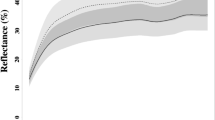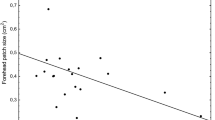Abstract
Females often base their mating preferences on male sexual secondary traits that are used to settle contests among males. Such traits are likely to be honest indicators of male quality if they are constantly used during costly male–male agonistic interactions. Carotenoid signals have been shown to work as a handicap because they are costly to produce. However, the role of carotenoids as “honest” signals during male contests is less clear, and it is not known whether a carotenoid-based trait can serve in both male–male competition and female choice. In this study, we studied the dual function of a carotenoid feather ornament in the rock sparrow (Petronia petronia), a bird species in which both sexes have a yellow throat patch whose size positively correlates with phenotypic measures. First, we investigated, in a field study, whether the size of a male’s yellow patch correlates with his ability to acquire a territory. Second, we tested the signal function of the yellow patch in two male–male interaction in captivity experiments. Finally, we measured female preference for males differing in throat patch size in a mate choice experiment. Our experiments revealed that the size of a male’s throat patch positively correlated with the number of nest boxes he was able to defend. Moreover, in controlled conditions, males with relatively large yellow patches had earlier access to food than those with small patches. Also, in an experiment in which a dummy rock sparrow with an experimentally manipulated yellow patch was positioned near a feeder, latency to feed by focal birds positively correlated with dummy patch size. Lastly, in a dichotomous mate choice experiment, females showed a proximity preference for males whose patch was experimentally enlarged. Taken together, these results suggest that the same carotenoid feather signal may be used in both male–male competition and female choice in this passerine bird.





Similar content being viewed by others
References
Alonso-Alvarez C, Doutrelant C, Sorci G (2004) Ultraviolet reflectance affects male–male interactions in the blue tit (Parus caeruleus ultramarinus). Behav Ecol 15:805–809
Amundsen T (2000) Why are female birds ornamented? Trends Ecol Evol 15:149–155
Andersson M (1994) Sexual selection. Princeton University Press, Princeton, New Jersey
Andersson S, Ahlund M (1991) Hunger affects dominance among strangers in house sparrows. Anim Behav 41:895–897
Belthoff JR, Dufty AM, Gauthreaux SA (1994) Plumage variation, plasma steroids and social-dominance in male house finches. Condor 96:614–625
Berglund A, Bisazza A, Pilastro A (1996) Armaments and ornaments: an evolutionary explanation of traits of dual utility. Biol J Linn Soc 58:385–399
Blount JD, Metcalfe NB, Birkhead TR, Surai PF (2003) Carotenoid modulation of immune function and sexual attractiveness in zebra finches. Science 300:125–127
Borgia G, Coleman SW (2000) Co-option of male courtship signals from aggressive display in bowerbirds. Proc R Soc Lond B 267:1735–1740
Bright A, Waas JR, King CM, Cuming PD (2004) Bill colour and correlates of male quality in blackbirds: an analysis using canonical ordination. Behav Processes 65:123–132
Brown MB, Brown CR (1988) Access to winter food resources by bright-versus dull-colored house finches. Condor 90:729–731
Burley NT (1988) Wild zebra finches have band-color preferences. Anim Behav 36:1235–1237
Burley NT, Price DK, Zann RA (1992) Bill color, reproduction and condition effects in wild and domesticated zebra finches. Auk 109:12–23
Candolin U (2000) Male–male competition ensures honest signaling of male parental ability in the three-spined stickleback (Gasterosteus aculeatus). Behav Ecol Sociobiol 49:57–61
Chew BP (1996) Importance of antioxidant vitamins in immunity and health in animals. Anim Feed Sci Technol 59:103–114
Cramp S, Perrins CM (1994) Handbook of the birds of the Western Palearctic. Oxford University Press, Oxford
Etman EJ, Lelieveld HM, Ten Cate C (2001) Male bill colour and competition in zebra finches. Behav Processes 55:119–124
Evans MR, Norris K (1996) The importance of carotenoids in signaling during aggressive interactions between male firemouth cichlids (Cichlasoma meeki). Behav Ecol 7:1–6
Faivre B, Gregoire A, Preault M, Cezilly F, Sorci G (2003) Immune activation rapidly mirrored in a secondary sexual trait. Science 300:103
Grafen A (1990) Biological signals as handicaps. J Theor Biol 144:517–546
Gray DA (1996) Carotenoids and sexual dichromatism in North American passerine birds. Am Nat 148:453–480
Griffith SC, Parker TH, Olson VA (2006) Melanin- versus carotenoid-based sexual signals: is the difference really so black and red? Anim Behav 71:749–763
Griggio M, Matessi G, Pilastro A (2003a) Male rock sparrow (Petronia petronia) nest defence correlates with female ornament size. Ethology 109:659–669
Griggio M, Tavecchia G, Biddau L, Mingozzi T (2003b) Mating strategies in the rock sparrow Petronia petronia: the role of female quality. Ethol Ecol Evol 15:389–398
Griggio M, Valera F, Casas A, Pilastro A (2005) Males prefer ornamented females: a field experiment of male choice in the rock sparrow. Anim Behav 69:1243–1250
Hartley RC, Kennedy MW (2004) Are carotenoids a red herring in sexual display? Trends Ecol Evol 19:353–354
Hill GE (1991) Plumage coloration is a sexually selected indicator of male quality. Nature 350:337–339
Hill GE (1994) Geographic-variation in male ornamentation and female mate preference in the house finch—a comparative test of models of sexual selection. Behav Ecol 5:64–73
Hill GE (1999a) Is there an immunological cost to carotenoid-based ornamental coloration? Am Nat 154:589–595
Hill GE (1999b) Mate choice, male quality and carotenoid-based plumage coloration. In: Adams N, Slotow R (eds) Proceedings of the 22nd international ornithology congress. University of Natal, Durban, pp 1654–1668
Hill GE, Farmer KL (2005) Carotenoid-based plumage coloration predicts resistance to a novel parasite in the house finch. Naturwissenschaften 92:30–34
Hill GE, Nolan PM, Stoehr AM (1999) Pairing success relative to male plumage redness and pigment symmetry in the house finch: temporal and geographic constancy. Behav Ecol 10:48–53
Holland B, Rice WR (1998) Perspective: chase-away sexual selection: antagonistic seduction versus resistance. Evolution 52:1–7
Hudon J (1994) Showiness, carotenoids, and captivity—a comment on Hill (1992). Auk 111:218–221
Jones IL, Hunter FM (1993) Mutual sexual selection in a monogamous seabird. Nature 362:238–239
Jones IL, Hunter FM (1999) Experimental evidence for mutual inter- and intrasexual selection favouring a crested auklet ornament. Anim Behav 57:521–528
Kodric-Brown A (1989) Dietary carotenoids and male mating success in the guppy: an environmental component to female choice. Behav Ecol Sociobiol 25:393–401
Leitao A, Riebel K (2003) Are good ornaments bad armaments? Male chaffinch perception of songs with varying flourish length. Anim Behav 66:161–167
Liker A, Székely T (1997) Aggression among female lapwings, Vanellus vanellus. Anim Behav 54:797–802
Lozano GA (1994) Carotenoids, parasites, and sexual selection. Oikos 70:309–311
MacDougall AK, Montgomerie (2003) Assortative mating by carotenoid-based plumage colour: a quality indicator in American goldfinches, Carduelis tristis. Naturwissenschaften 90:464–467
Manly BFJ (1991) Randomization and Monte Carlo methods in biology. Chapman & Hall, London
Mantel N (1967) The detection of disease clustering and a generalized regression approach. Cancer Res 27:209–220
Mateos C, Carranza J (1999) Effects of male dominance and courtship display on female choice in the ring-necked pheasant. Behav Ecol Sociobiol 45:235–244
McGraw KJ, Hill GE (2000) Carotenoid-based ornamentation and status signaling in the house finch. Behav Ecol 11:520–527
Møller AP, Biard C, Blount JD, Houston DC, Ninni P, Saino N, Surai PF (2000) Carotenoid-dependent signals: indicators of foraging efficiency, immunocompetence or detoxification ability? Avian Poult Biol Rev 11:137–159
Navara KJ, Hill GE (2003) Dietary carotenoid pigments and immune function in a songbird with extensive carotenoid-based plumage coloration. Behav Ecol 14:909–916
Nicoletto PF (1995) Offspring quality and female choice in the guppy, Poecilia reticulata. Anim Behav 49:377–387
Norušis MJ (1993) SPSS for Windows Base System User’s Guide Release 6.0. SPSS, Chicago
Olson VA, Owens IPF (1998) Costly sexual signals: are carotenoids rare, risky or required? Trends Ecol Evol 13:510–514
Olson VA, Owens IPF (2005) Interspecific variation in the use of carotenoid-based coloration in birds: diet, life history and phylogeny. J Evol Biol 18:1534–1546
Payne RW, Arnold GM (2003) GenStat® Release 7.1 Reference Manual. VSN International, Oxford
Peters A, Denk AG, Delhey K, Kempenaers B (2004) Carotenoid-based bill colour as an indicator of immunocompetence and sperm performance in male mallards. J Evol Biol 17:1111–1120
Pilastro A, Biddau L, Marin G, Mingozzi T (2001) Female brood desertion increases with the number of available mates in the Rock Sparrow. J Avian Biol 32:68–72
Pilastro A, Griggio M, Biddau L, Mingozzi T (2002) Extrapair paternity as a cost of polygyny in the rock sparrow: behavioural and genetic evidence of the ‘trade-off’ hypothesis. Anim Behav 63:967–974
Pilastro A, Griggio M, Matessi G (2003) Male rock sparrows adjust their breeding strategy according to female ornamentation: parental or mating investment? Anim Behav 66:265–271
Preault M, Deregnaucourt S, Sorci G, Faivre B (2002) Does beak coloration of male blackbirds play a role in intra and/or intersexual selection? Behav Processes 58:91–96
Pryke SR, Andersson S (2003a) Carotenoid-based epaulettes reveal male competitive ability: experiments with resident and floater red-shouldered widowbirds. Anim Behav 66:217–224
Pryke SR, Andersson S (2003b) Carotenoid-based status signalling in red-shouldered widowbirds (Euplectes axillaris): epaulet size and redness affect captive and territorial competition. Behav Ecol Sociobiol 53:393–401
Pryke SR, Andersson S, Lawes MJ (2001a) Sexual selection of multiple handicaps in the red-collared widowbird: female choice of tail length but not carotenoid display. Evolution 55:1452–1463
Pryke SR, Lawes MJ, Andersson S (2001b) Agonistic carotenoid signalling in male red-collared widowbirds: aggression related to the colour signal of both the territory owner and model intruder. Anim Behav 62:695–704
Senar JC, Camerino M (1998) Status signalling and the ability to recognize dominants: an experiment with siskins (Carduelis spinus). Proc R Soc Lond B 265:1515–1520
Senar JC, Escobar D (2002) Carotenoid-derived plumage coloration in the siskin Carduelis spinus is related to foraging ability. Avian Sci 2:19–24
Senar JC, Domenech J, Camerino M (2005) Female siskins choose mates by the size of the yellow wing stripe. Behav Ecol Sociobiol 57:465–469
Sokal RR, Rohlf FJ (1995) Biometrics. Freeman, San Francisco, CA
Svensson L (1992) Identification guide to European passerines, 4th edn. British Trust for Ornithology, Thetford
Tarof SA, Dunn PO, Whittingham LA (2005) Dual functions of a melanin-based ornament in the common yellowthroat. Proc R Soc Lond B Biol Sci 272:1121–1127
von Schantz T, Bensch S, Grahn M, Hasselquist D, Wittzell H (1999) Good genes, oxidative stress and condition-dependent sexual signals. Proc R Soc Lond B 266:1–12
Wedekind C, Meyer P, Frischknecht M, Niggli UA, Pfander H (1998) Different carotenoids and potential information content of red coloration of male three-spined stickleback. J Chem Ecol 24:787–801
Wong BBM, Candolin U (2005) How is female mate choice affected by male competition? Biol Rev 80:559–571
Zahavi A (1975) Mate selection—a selection for a handicap. J Theor Biol 53:205–214
Acknowledgments
We thank the many assistants who helped in the fieldwork. We are very grateful to Toni Mingozzi for the scientific advice and the practical help in the field. We are also indebted to Riccardo Stradi and Folco Giomi for analyzing the carotenoids of the rock sparrow’s yellow feathers. We also thank Juan C. Senar, Jonathan P. Evans, Kevin J. McGraw, and three anonymous referees for their helpful comments on the paper.
Author information
Authors and Affiliations
Corresponding author
Additional information
Communicated by K. McGraw
Rights and permissions
About this article
Cite this article
Griggio, M., Serra, L., Licheri, D. et al. Armaments and ornaments in the rock sparrow: a possible dual utility of a carotenoid-based feather signal. Behav Ecol Sociobiol 61, 423–433 (2007). https://doi.org/10.1007/s00265-006-0270-5
Received:
Revised:
Accepted:
Published:
Issue Date:
DOI: https://doi.org/10.1007/s00265-006-0270-5




